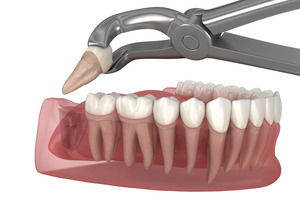
A tooth extraction is considered a routine dental procedure, but despite that fact, many people have an inaccurate idea of what it really entails. Before you make any decisions regarding your dental care, you should make sure that all the information you have is factual. Here is the truth to debunk these 5 myths that you may have heard about tooth extractions.
Myth 1: Having a Tooth Extracted Causes a Lot of Pain
Thanks to the many advancements modern dentistry has made when it comes to keeping patients comfortable, having a tooth extracted is not the painful experience that many people assume it to be. Your dentist will always take the time to numb your mouth before the procedure begins, and they will be as gentle as possible as they work to remove the tooth. Additionally, you can have sedation dentistry administered during your tooth extraction, which will keep you in a relaxed state while your mouth is being worked on.
Myth 2: Tooth Extraction is Followed by a Lengthy Recovery Process
While there will be a recovery period after your tooth extraction, it likely won’t be as long as you might think. It can take about one to two weeks for the mouth to finish healing after the procedure, but any post-extraction discomfort you experience should fade after a matter of days, especially if you’re careful about following the aftercare instructions you receive.
Myth 3: Wisdom Teeth Always Need to Be Extracted
Wisdom tooth extractions are so common that they are sometimes seen as a rite of passage for young adults. However, the procedure is not always necessary. If wisdom teeth are able to fully erupt without damaging nearby teeth or causing any other problems, they can be left alone. Your dentist will need to take a close look at your mouth and jaw in order to determine whether a wisdom tooth extraction is required in your case.
Myth 4: An Infected or Damaged Tooth Should Always Be Removed
Even if a tooth is badly damaged or infected, removing it should always be treated as a last resort. Your dentist will always consider other options that could potentially save the tooth, such as root canal treatment or a dental crown. Even though extracted teeth can be replaced, keeping your natural teeth is generally better for your oral health as well as your overall well-being; thus, a tooth extraction will only be recommended if there’s simply no other choice.
Myth 5: You Don’t Need to Replace an Extracted Tooth
Some people think it’s okay not to replace an extracted tooth if the empty space won’t be visible when they smile. Unfortunately, this overlooks the fact that a missing tooth is not simply a cosmetic issue. An incomplete smile can lead to all sorts of problems; for example, you may suffer from digestive issues because you can no longer chew your food properly. Instead of simply ignoring the empty space, ask your dentist about having it filled with a dental bridge, a partial denture, or a dental implant.
It’s important to make sure that you have all the facts regarding any dental treatments you receive. If you want to confirm the truth of anything else you’ve heard about tooth extractions, be sure to ask your dentist.
About the Author
Dr. David Salibian is the trusted dentist at EyeSmile Dentistry and Optometry of Belmont. He earned his dental degree at the Tufts University School of Dental Medicine. He’s able to offer his patients gentle tooth extractions as well as relaxing dental sedation and a variety of tooth replacement options. To schedule a consultation with Dr. Salibian, visit his website or call (617) 484-7869.
